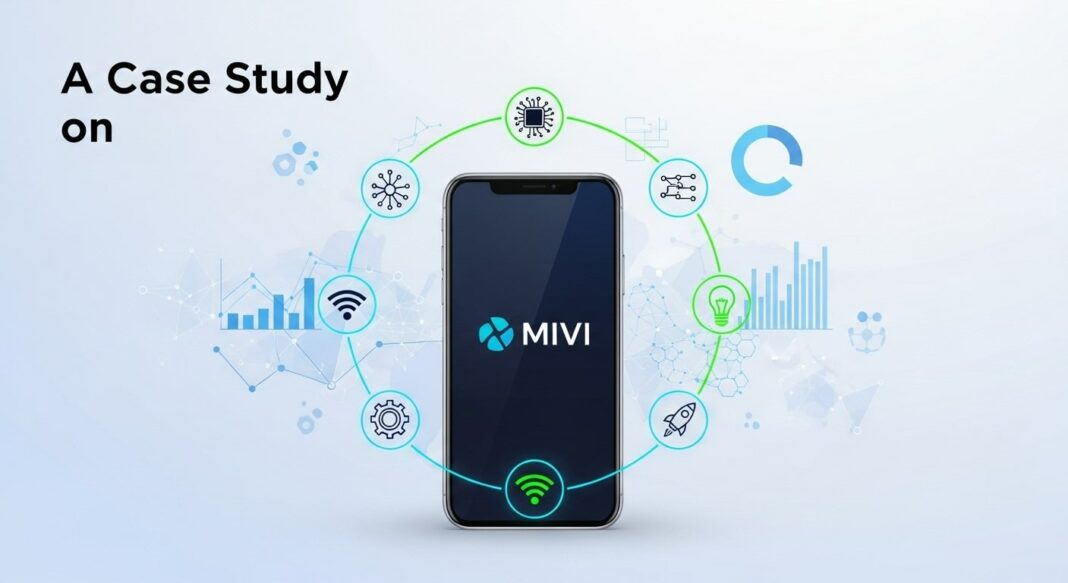When studying Indian startups, a case study on MIVI offers quite a few lessons about ambition, risks, and the slow work of credibility. MIVI began almost modestly, but has gradually moved toward manufacturing, design control and product differentiation. In order to see how brands in India may evolve, this case is mostly useful as a reference.
Early Phase: From Accessories to Audio
MIVI (Avishkaran Industries Pvt. Ltd.) was co-founded by Viswanadh Kandula and Midhula Devabhaktuni around 2015–16. At that time, they identified that many imported accessories and audio gadgets in India suffered from quality control and after‑sales issues. In order to attempt a better path, MIVI started with cables, chargers and accessories – mostly importing initially, but gradually bringing in design and assembly control.
In 2020, MIVI launched ROAM 2, their first fully Made in India Bluetooth speaker – that product was advertised as being designed, built, tested and boxed fully within India. That step was a symbolic shift: from being a reseller or importer to being a brand that wants (and claims) actual production capability.
By 2022, MIVI rolled out its FORT series soundbars (models like Fort S60 and S100), curated especially for Indian musical preferences (compact form, built-in subwoofer, multiple input modes). That move showed they were thinking beyond commodity specs, trying to match local tastes and home environments.
Strategic Moves & Evolution in A Case Study on MIVI
A Case Study on MIVI is interesting because the brand didn’t suddenly leap to full tech company – it stepped carefully, mostly building piece by piece.
1. Manufacturing Investment & Capacity Building
In April 2024, MIVI launched their second factory in Hyderabad. The project cost ₹200 crore. This facility’s purpose is to undertake both research and development and create parts. It can make up to 100,000 audio hardware pieces every day. This expansion doubles the amount of work they can do compared to the old plant.
This new plant is slated to create around 2,000 jobs. The aim is to move more of the value chain in house, reducing reliance on external suppliers and improving margins. In order to sustain growth, such vertical control is quite pivotal.
2. The AI / Smart Earbuds Push
In 2025, MIVI launched its AI earbuds, priced at ₹6,999, with active noise cancellation, 3D soundstage, spatial audio and a custom voice assistant supporting eight Indian languages. Their marketing frames it as a leap: it’s not just an earbud, but a conversational interface for daily tasks like cooking, news, or interviews.
The company claims that this AI platform is expected to triple revenues the coming year. They are also adding wearables, IoT and home security to their product pipeline, all of which will be based on the same AI platform.
3. Revenue Targets & Scaling
It is believed that MIVI made more than ₹300 crore in sales in FY25. They hope to produce ₹1,000 crore in FY26 and they think that both their present products and new AI-based products would help them get there. They also seek to expand their firm into new areas, such as the U.S., the Middle East, and Europe.
In order to support that, they intend to strengthen both their online and offline presence, and possibly act as a manufacturing partner for global brands.
In a case study on MIVI, these moves show a shift from being niche to trying to scale broadly.
Metrics and Milestones
Here’s a summarized timeline reflecting that a case study is a journey of incremental leaps, rather than one big instant success:
| Year | Milestone / Metric | Interpretation |
| ~2015–16 | Company founded, started with accessories | Early bootstrap phase |
| 2020 | Launch of ROAM 2 (first fully Indian‑made speaker) | Branding + manufacturing shift |
| 2022 | Launch FORT soundbars tailored for India | Product differentiation |
| Apr 2024 | Lays foundation for second plant (₹200 cr) | Big scale push |
| 2025 | AI Earbuds launched at ₹6,999 | Technology differentiation |
| FY25 | ₹300+ crore revenue | Proof of scaling |
| FY26 goal | ₹1,000 crore revenue | Aggressive target |
Challenges, Customer Feedback & Risks
Any real case study must reckon with problems. In a case study on MIVI, several user complaints and systemic challenges are visible, which mostly must be navigated carefully.
User Complaints & After‑Sales Issues
- On Reddit, one user reported a MIVI soundbar that lost HDMI‑ARC connectivity and Bluetooth, and found that the support team would offer only a partial refund (half) instead of full replacement – even though the item was under warranty.
- Another user claimed repeated defects in low‑cost MIVI earphones: buzzing, fading sound, and requiring multiple replacements within months.
- Some users have also had trouble getting replacements through Flipkart or MIVI support, saying they were turned down or had to wait a long time.
- Some people don’t believe the “Made in India” claim and think that components or subunits might still be brought in from other countries.
- These criticisms show that it is sometimes harder to scale up product lines and customer service than it is to make the product itself.
Other Risks & Structural Challenges
- Cost competitiveness: Local manufacturing in India, especially in early stages, likely has higher costs than large global manufacturers or offshore units. MIVI must optimize operations to survive pricing pressure.
- Component supply chain: To have reliable in‑house or local component production requires sustained investment, supplier networks, and scale.
- Maintaining consistency: As volume rises, defect rates, quality drift, and process variations become harder to control.
- Consumer trust & perception: If one popular claim (such as “100% made in India”) is discovered to be too strong, it could hurt trust. One way MIVI is trying to make things more real is through their #HamaraHindustaan campaign.
- Competitive pressure: Brands like boAt, Noise, and a lot of Chinese imports compete a lot on pricing, features and advertising. MIVI needs to find a way to defend its position.
- Scaling distribution & service network: Offline reach, repair centers, replacements across India’s geography is logistically tough.
Strategic Lessons
From MIVI’s journey, some takeaways are quite instructive – especially for Indian tech hardware brands aspiring to grow:
- Build credibility step by step
Starting with accessories is less risky. Once you understand supply chains, then invest in design, then manufacturing. MIVI mostly followed that path.
- Differentiate via local tuning and understanding
Products made for Indian music tastes, home surroundings and user habits may be more appealing than generic global electronics.
- Invest in service and support early
It’s not only about selling more products; replacement, warranty and after-sales assistance can make or break a company’s image.
- Use transparency to build trust
Calling out “made vs assembled in India” is risky but likely necessary. Consumers are wise to marketing claims; authenticity helps.
- Maintain operational discipline as you scale
Cost control, defect management and supply chain robustness must all grow at the same time as revenue.
- Set aggressive but realistic targets
MIVI wants to make ₹1,000 crore in FY26, which is a big objective. They have to do what they say, not simply talk about it.
Conclusion
A case study on MIVI shows that building a tech brand in India is quite possible – but it takes time, patience, clarity and consistent investment. MIVI seems mostly successful because they didn’t rush everything, they tried to understand what their customers genuinely needed and they gradually built capabilities rather than just following hype. In order to sustain their success, they will need to keep quality high, stay honest with consumers and manage costs carefully.
Frequently Asked Questions (FAQs)
Q1. Is MIVI’s AI earbuds really a smart move or too early?
It is risky, but quite potentially rewarding. In a case study on MIVI, the AI earbuds represent their attempt to move from hardware to experience. If the AI works well, it could help them command more margin and lock users in. But if the AI is buggy or underwhelming, it may hurt credibility.
Q2. Are MIVI’s claims of manufacturing in India credible?
They have made public claims: their new plant is intended to integrate R&D and component manufacturing. Also, in 2020, they claimed ROAM 2 is their first end‑to‑end Made in India product. But user skepticism and reports suggest that parts of the supply chain may still rely on imported subunits.
Q3. Why do customers complain about support delays or partial refunds?
Scaling support is not easy at all. Some complaints say that MIVI support marked problems as fixed too soon or refused to fully replace them because the models were no longer available. This means that there may be a lot of stress on the backlog, the stock of replacement parts, or the company’s own rules.
Q4. Can MIVI meet its ₹1,000 crore goal?
It’s a big goal. It might be conceivable if their AI ecosystem grows and they use all of their production capacity. But a lot relies on how much people want it, how many other people are selling it, how well it’s done and how much money it makes.
Q5. What should MIVI focus on now to improve odds?
They want to increase after-sales assistance, keep quality the same, manage cost reductions, reach more consumers with repairs and deliveries and test their AI capabilities with real customers.
Also read: PedroVazPaulo Business Consultant

I am a content writer with proven experience in crafting engaging, SEO-optimized content tailored to diverse audiences. Over the years, I’ve worked with School Dekho, various startup pages, and multiple USA-based clients, helping brands grow their online visibility through well-researched and impactful writing.


